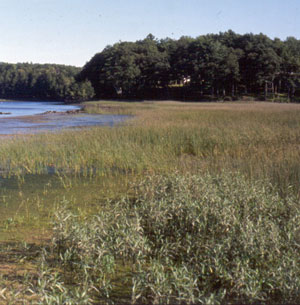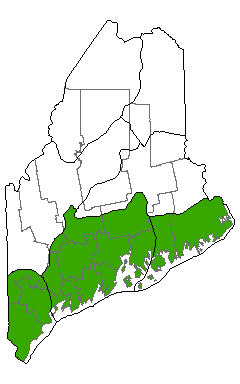DACF Home → Bureaus & Programs → Maine Natural Areas Program → Communities, Plants, and Animals → Natural Community Fact Sheets → Mixed Saltmarsh
Printer Friendly Fact Sheet - 650 KB pdf (Get a free copy of Adobe Acrobat Reader)
Mixed Saltmarsh
Common Name: Mixed Graminoid - Forb Saltmarsh; State Rank: S3

- Community Description
- Soil and Site Characteristics
- Diagnostics
- Similar Types
- Conservation, Wildlife and Management Considerations
- Distribution
- Characteristic Plants
- Associated Rare Plants
- Associated Rare Animals
- Examples on Conservation Lands You Can Visit
Community Description: These saltmarshes contain a mixture of graminoids and forbs, sometimes with patches of saltmarsh cordgrasses, but saltmeadow cordgrass is not strongly dominant. Chair-maker’s rush is almost always present, at least in small amounts. Dominants can vary, but indicator species include creeping bentgrass, freshwater cordgrass, sea lavender, wire rush, saltmarsh bulrush, New England aster, saltmarsh sedge, and narrow-leaved cattail. Sweetgrass is often present, though not abundant. The vegetation occurs as a mosaic of dominants and lacks the strong zonation typical of the larger Spartina Saltmarshes. Back to top.
Soil and Site Characteristics: These are often fringe marshes in sheltered coastal pockets, estuaries, and tidal creeks; not typically covering large acreages although they may be strung along a fairly long stretch of shoreline. They often occur along tidal creeks, or as a shoreline fringe in coves. Vegetation consists predominantly of low marsh (saltmarsh regularly inundated twice daily by tides). Back to top.
Diagnostics: These are tidal marshes in which various saltmarsh plants share dominance with cordgrasses and/or black-grass; chair-maker’s rush is typically present and may be dominant; saltmarsh sedge is also characteristic. Vegetation tends to be patchy rather than zoned. Back to top.
Similar Types: Salt-hay Saltmarshes have many of the same species, but have much greater relative cover of saltmeadow cordgrass, smooth cordgrass, and black-grass. They also appear more uniform, and tend to occur at the outer reaches of estuaries (back-barrier marshes and finger marshes). Brackish Tidal Marshes also share many species, but lack the saltmarsh cordgrasses and other strictly saltmarsh species (black-grass, saltmarsh bulrush, saltmarsh false-foxglove, sea lavender, etc.). Back to top.
Conservation, Wildlife and Management Considerations: Saltmarshes have received considerable conservation attention. Many occur on public lands or private conservation lands, only a few of which are listed. With development of the uplands that border these marshes, maintenance of appropriate wetland buffers can help reduce degradation that could result from adjacent land uses.
Saltmarshes are important nesting habitat for several uncommon sparrows: Nelson’s sharp-tailed sparrow and two uncommon species -- the saltmarsh sharp-tailed sparrow and the seaside sparrow. These wetlands also provide foraging habitat for a large number of wading birds and shorebirds, including the rare least tern. The big bluet, a rare damselfly, inhabits saltmarsh ponds with emergent vegetation in southern Maine. Back to top.
Distribution: Coastwide; almost all of the east coastal Maine saltmarshes contain this type. Extends eastward into the Canadian Maritimes (Laurentian Mixed Forest Province) and westward into New Hampshire and Massachusetts. Landscape Pattern: Small Patch. Back to top.


Characteristic Plants: These plants are frequently found in this community type. Those with an asterisk are often diagnostic of this community.
- Herb
- Alkali bulrush*
- Black-grass*
- Chaffy sedge*
- Chair-maker's rush*
- Common arrow-grass
- Creeping bentgrass*
- Freshwater cordgrass
- New York aster*
- Salt-loving spikerush*
- Saltmeadow cordgrass*
- Wire rush*
- Big bluet
- Black-crowned night-heron
- Laughing gull
- Least tern
- Saltmarsh sharp-tailed sparrow
- Short-eared owl
Examples on Conservation Lands You Can Visit
| Example | County |
|---|---|
| Cobscook Bay State Park | Washington Co. |
| Great Wass Island Preserve | Washington Co. |
| Petit Manan National Wildlife Refuge | Hancock Co. |
| Reid State Park | Sagadahoc Co. |
| Scarborough Marsh Wildlife Management Area | Cumberland Co. |